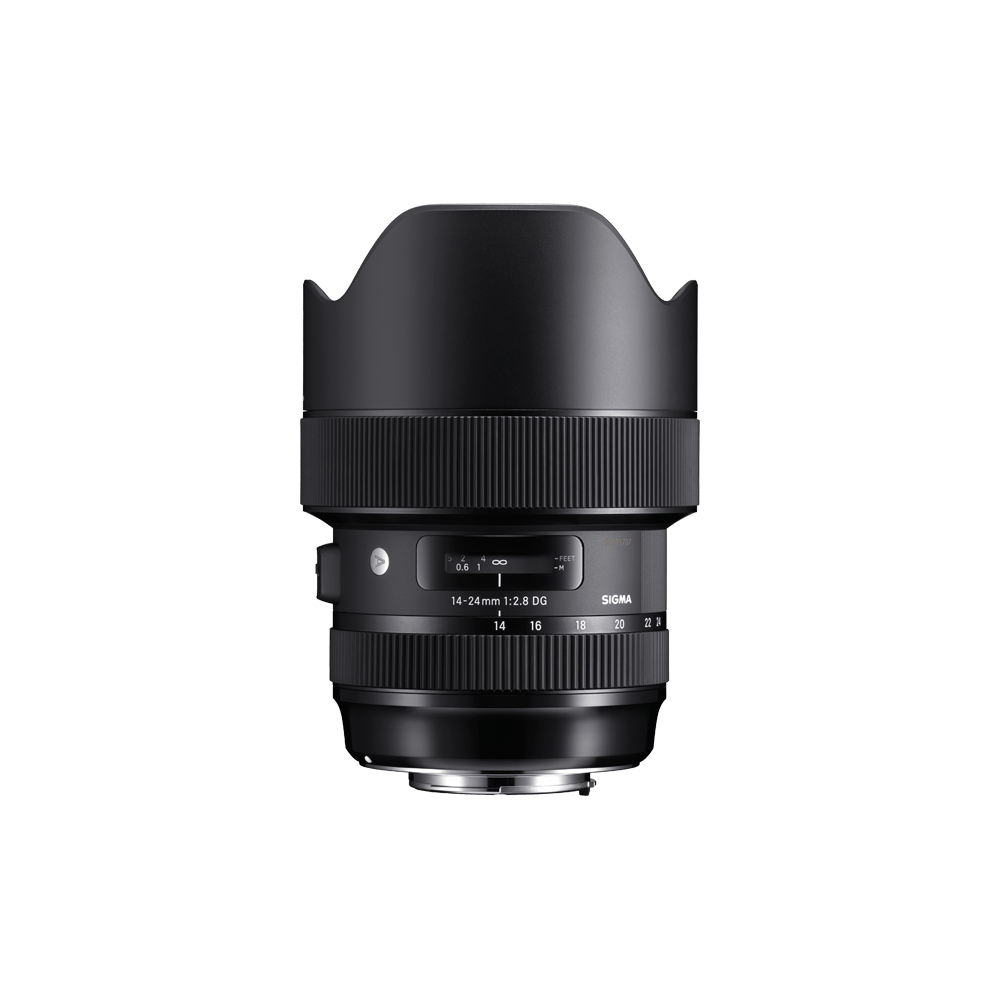
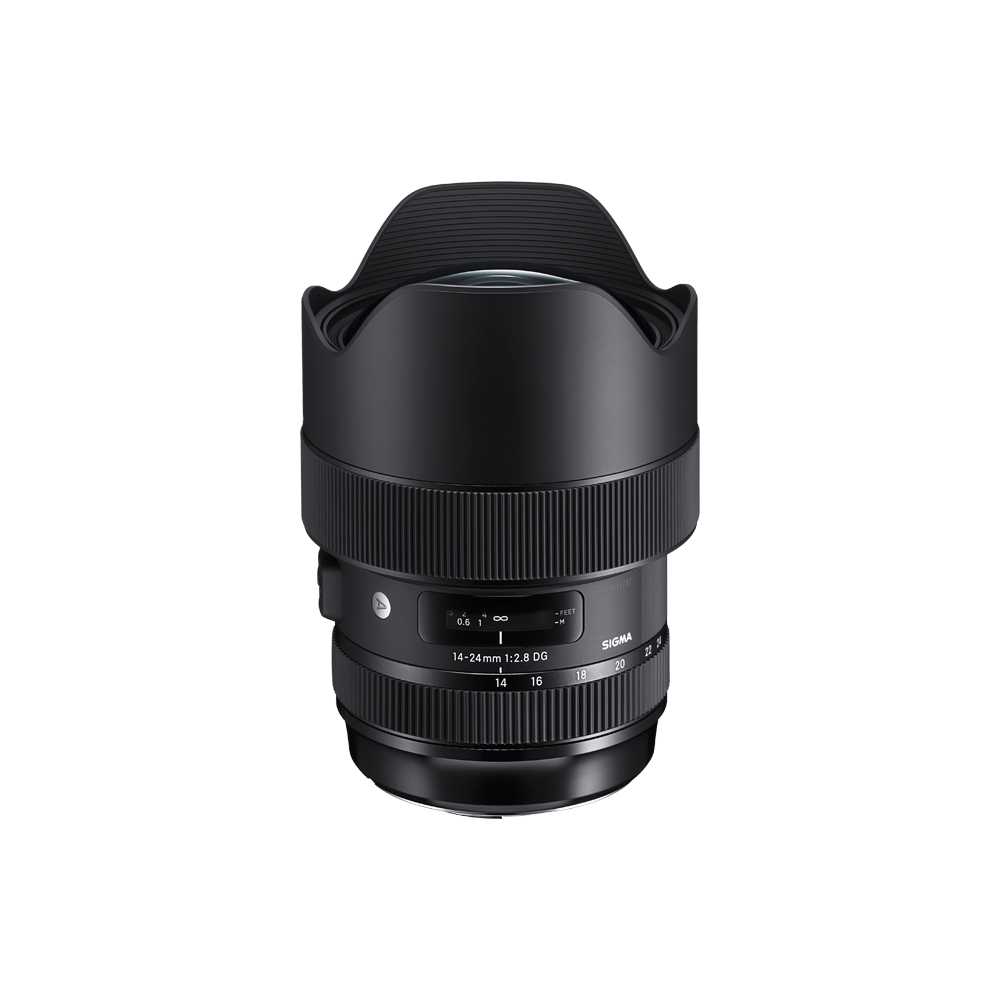


-
Camera Type
DSLR
-
Corresponding Mount
SIGMA SA-mount, Canon EF mount, Nikon F mount
-
Sensor Format
Full-frame [DG]
-
Lens Construction
17 elements in 11 groups
-
Angle of View
114.2° - 84.1°
-
Number of Diaphragm Blades
9 (Rounded diaphragm)
-
Minimum Aperture
F22
-
Minimum Focusing Distance
26cm* / 10.2 in.* * At 24mm end of the zoom range
-
Maximum Magnification Ratio
1:5.4
-
Dimensions (Diameter × Length)
Φ96.4mm × 135.1mm / Φ3.8in. × 5.3in.
*The length of a lens is measured from the filter surface to its mount.
-
Weight
1,150g / 40.6oz.
-
Edition Number
A018
The three-digit code on the surface of the lens is to indicate the year the lens was first released.
(Since it is different from the year of manufacture, the release year and edition number may not match depending on the mount.) -
Supplied Accessories
・Case
・COVER LENS CAP LC964-01
・REAR CAP LCR II -
Mount / Product Barcode
SIGMA SA-mount:00-85126-21256-8
Nikon F mount:00-85126-21255-1
Canon EF mount:00-85126-21254-4
-
Camera Compatibility
LINK
-
* All figures calculated by Sigma SA mount.
* The Nikon mount version of this lens includes an electromagnetic diaphragm mechanism. Functionality may be limited on some camera bodies. For Nikon F mount cameras, please see (*)Nikon camera compatibility(*)Nikon F mount camera compatibility
Lenses for Nikon F mount with an electromagnetic diaphragm mechanism can be used with the following cameras.
Z7Ⅱ※,Z7※,Z6Ⅱ※,Z6※,Z5※,Z50※,D6, D5, D4S, Df, D850, D810, D810A, D780, D750, D610, D500, D7500, D7200, D7100, D5600, D5500, D5300, D5200, D5100, D5000, D3500, D3400, D3300, D3200, D3100
※Can be used with the Nikon "Mount Adapter FTZ" attachedBefore using with one of the cameras listed below, please update the lens to the latest firmware version.
D4, D3X, D3S, D3, D800, D800E, D700, D600, D300S, D300, D7000
* The lens cannot be used with the cameras not listed above (including film single‐lens reflex cameras).
-
Outstanding Art line image quality
Designed to team up with 50-megapixel-plus cameras
Designed to team up with 50-megapixel-plus cameras and offer top-level optical performance throughout the zoom range, the 14-24mm F2.8 DG HSM | Art incorporates three FLD glass elements, three SLD glass elements, and three aspherical lens elements, including one large-diameter aspherical element. Effective distribution of these high-refractive-index glass elements further enhances the corrective effect of the FLD and SLD glass. This optical system minimizes transverse chromatic aberration and other optical aberrations, resulting in outstanding high-resolution image quality.
The first element in the optical system is a large-diameter aspherical lens. Optimizing the power distribution of this and the other lens elements minimizes distortion to 1% or lower.* As a result, points of light appear as points without streaking from the center of the image to the edge, and the light volume is also abundant throughout the frame. In addition, simulations performed from the design stage onward have helped minimize flare and ghosting. In combination, these technologies ensure excellent ultra-wide-angle performance.
* At infinity focus
-
Exclusive low-dispersion glass
The degree to which light is refracted by glass depends on the light’s wavelength. This fact causes different colors of light to focus at slightly different points. The result is chromatic aberration, the color fringing that is particularly noticeable in telephoto lenses. Most chromatic aberration can be removed by combining a high-refractivity convex lens element with a low-refractivity concave element. Yet residual chromatic aberration known as “secondary spectrum” may still remain. To minimize this secondary spectrum, which can be a serious issue with conventional lenses, Sigma lenses feature up to three types of exclusive low-dispersion glass offering superior performance: ELD (Extraordinary Low Dispersion), SLD (Special Low Dispersion) and FLD (“F” Low Dispersion). In particular, FLD glass offers ultra-low dispersion in combination with high transmittance and the anomalous dispersion characteristics of fluorite. Meticulous deployment of these types of exclusive low-dispersion glass and optimization of power distribution gives Sigma lenses superlative image rendition undiminished by residual chromatic aberration.
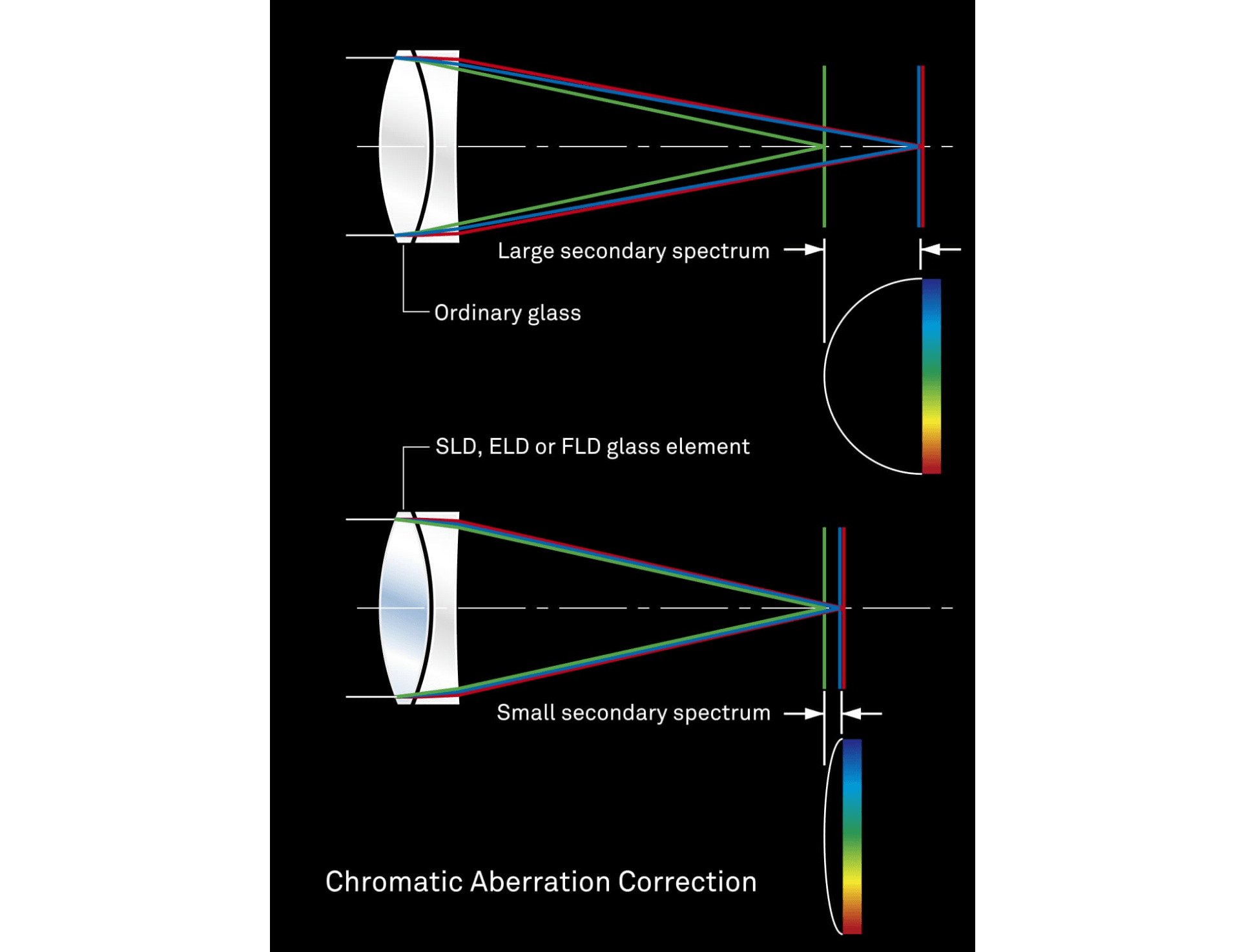
-
Designed to minimize flare and ghosting
From an early stage in the lens design process, flare and ghosting have been measured to establish an optical design resistant to strong incident light sources such as backlighting. Sigma’s Super Multi-Layer Coating reduces flare and ghosting to help photographers produce sharp and high contrast images even in backlit conditions.

-
Compatible with Canon Lens Aberration Correction*
The Canon mount lens is compatible with the Canon Lens Aberration Correction function. Matching the optical characteristics of the lens, these functions perform in-camera corrections of peripheral illumination, chromatic aberrations, distortion, and more.
The Canon mount lens is compatible with the Canon Lens Aberration Correction function. Matching the optical characteristics of the lens, these functions perform in-camera corrections of peripheral illumination, chromatic aberrations, distortion, and more.
* Function not available on all Canon cameras. Further, available corrections may vary by Canon camera model.
(*)Canon camera compatibility
(*)Canon camera compatibility
The SGV interchangeable lens for Canon EF mount supports the "lens optical correction" installed in the following cameras.
Canon camera compatibility
EOS R5※, EOS R6※, EOS R※, EOS RP※, EOS Ra※, EOS-1D X Mark III,EOS 1DX mark Ⅱ, EOS 5Ds, EOS 5DsR, EOS 5D mark Ⅳ, EOS 6D mark Ⅱ, EOS 90D, EOS 80D, EOS 8000D(EOS Rebel T6s, EOS 760D), EOS 9000D(EOS 77D), EOS Kiss X8i(EOS Rebel T6i, EOS 750D), EOS Kiss X9i(EOS Rebel T7i, EOS 800D), EOS Kiss X9(EOS Rebel SL2, EOS 200D), EOS Kiss X10i, EOS Kiss X10
※ For SGV interchangeable lenses released before 2017* , it is necessary that the lens firmware is updated to Ver.2.00 or later.
* The release year can be confirmed by the edition number (A017, C015, etc.) engraved on the lens barrel.※After setting the Digital Lens Optimizer to [OFF], set the "Peripheral Illumination Correction", "Chromatic Aberration Correction", and "Distortion Correction" of the "Lens Aberration Correction" function to [ON] to achieve the appropriate corrections in accordance with the optical characteristics of each lens.
-
Professional specifications
Allowing photographers to work in all types of weather
Like Sigma’s Sports line lenses, the 14-24mm F2.8 DG HSM | Art features a highly effective dust and splash resistant structure* with special sealing at the mount connection, manual focus ring, zoom ring, and cover connection, allowing photographers to work in all types of weather. In addition, the front of the lens is protected by a water- and oil-repellent coating that makes cleaning easy. The high-speed, high-accuracy autofocus helps photographers react in an instant to get those special shots.
* Although this construction allows the lens to be used in light rain, it is not the same as being waterproof.

-
Fast AF with full-time manual focus
Full-time manual focus function allows the lens to be switched to manual focus simply by rotating the focus ring.
Note: The operation of full-time MF may vary based on mount type.
-
High-precision, rugged brass bayonet mount
The brass mount combines high precision with rugged construction. Its treated surfaces and enhanced strength contribute to the exceptional durability of the lens.

-
Rounded diaphragm
The 9-blade rounded diaphragm creates an attractive blur in the out-of-focus areas of the image.

-
Nikon electromagnetic diaphragm mechanism included
The lens for the Nikon camera includes the electromagnetic diaphragm mechanism and is able to receive the appropriate signals from the camera body. This feature ensures precision diaphragm control and stable Auto Exposure (AE) performance during continuous shooting.
(*)Nikon camera compatibility
(*)Nikon F mount camera compatibility
Lenses for Nikon F mount with an electromagnetic diaphragm mechanism can be used with the following cameras.
Z7Ⅱ※,Z7※,Z6Ⅱ※,Z6※,Z5※,Z50※,D6, D5, D4S, Df, D850, D810, D810A, D780, D750, D610, D500, D7500, D7200, D7100, D5600, D5500, D5300, D5200, D5100, D5000, D3500, D3400, D3300, D3200, D3100
※Can be used with the Nikon "Mount Adapter FTZ" attachedBefore using with one of the cameras listed below, please update the lens to the latest firmware version.
D4, D3X, D3S, D3, D800, D800E, D700, D600, D300S, D300, D7000
* The lens cannot be used with the cameras not listed above (including film single‐lens reflex cameras). -
Introducing new Front Conversion Service
Today’s virtual reality creators favor multi-camera videography that leverages the capability of ultra-wide-angle lenses. Addressing this trend, Sigma is offering the new Front Conversion Service (charges apply), in which Sigma converts the petal-type hood of the 14-24mm F2.8 DG HSM | Art lens to an exclusive round component. This altered front structure allows the lens to be deployed with greater freedom in multi-camera VR videography. The new front also helps prevent the lens from interfering with other lenses or from casting a visible shadow. The use of this service has no impact on the validity of the product warranty.

-
Front Conversion Service
LINK
Lens construction
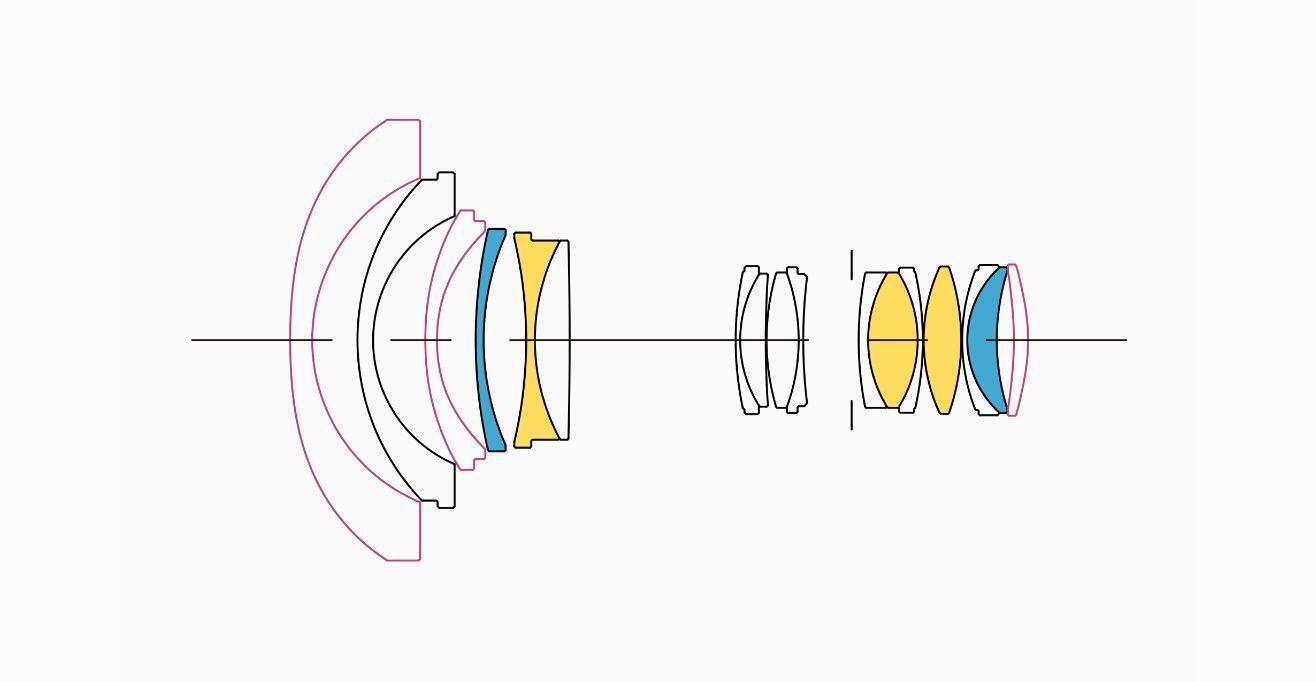
FLD glass
SLD glass
Aspherical lens
MTF Chart
The MTF (Modulation Transfer Function) is one of the measurements for evaluating a lens’ performance, and it shows how faithfully the contrast of the subject can be reproduced on the image plane. The horizontal axis shows the image height (distance from the center of the image in mm) and the vertical axis shows the contrast value (maximum value is 1).
The closer the 10 line pairs/mm curve is to 1, the higher the contrast and clarity of the lens is, and similarly, the closer the 30 line pairs/mm curve is to 1, the better the resolution and sharpness of the lens is.
*The MTF chart depicts the result at the wide-open aperture.
*For mirrorless lenses that support distortion correction, the horizontal axis shows the image height equivalent to when an L-Mount lens is attached to a Sigma L-Mount camera with distortion correction applied. (The effect of distortion correction may differ depending on the mount and camera used.)
*The spatial frequency indicates the variation on the image plane before distortion correction is performed.
-
Spatial frequency
S:Sagittal Line
M:Meridional Line
-
10lp/mm
-
30lp/mm
Diffraction MTF
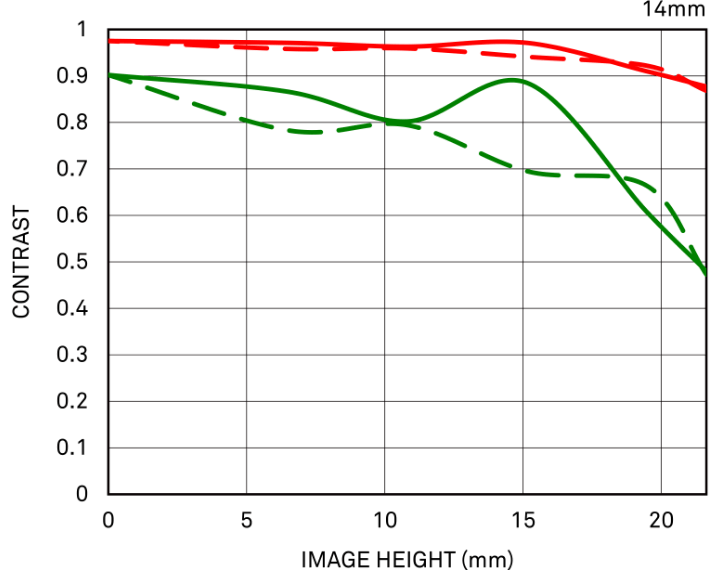
Diffraction MTF
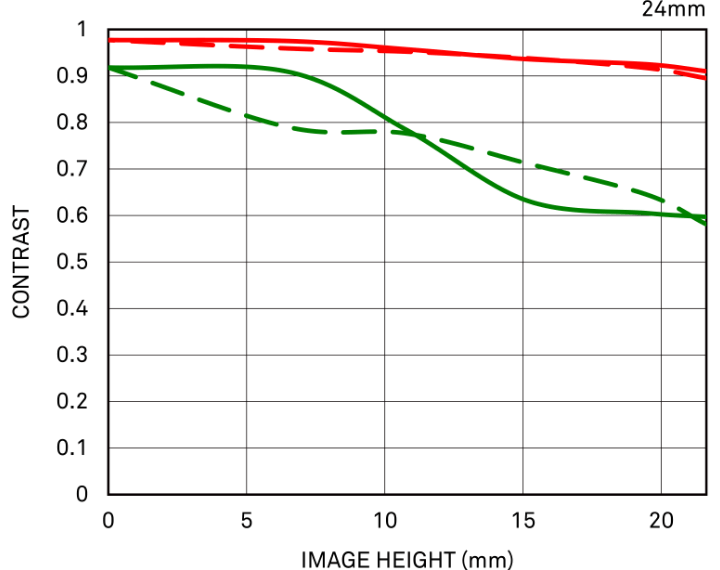
Geometrical MTF
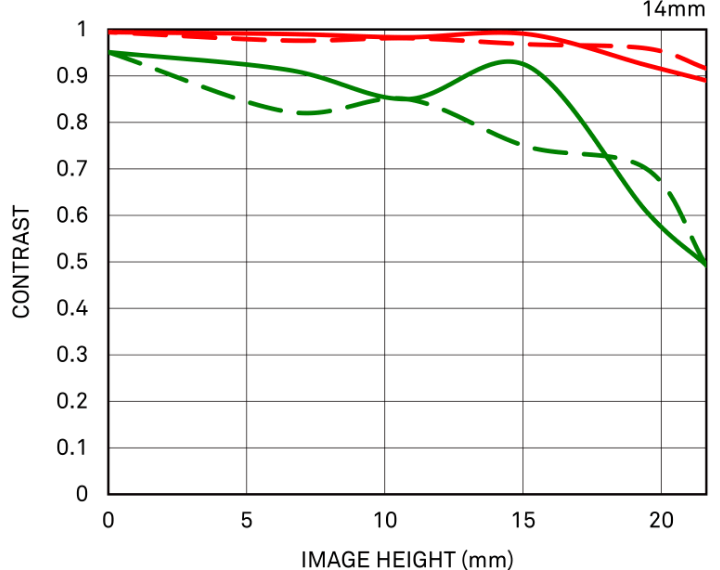
Geometrical MTF
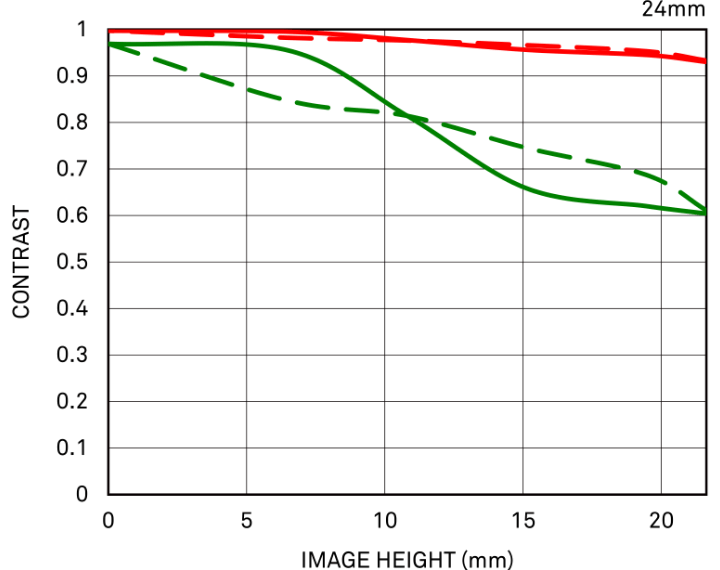
Distortion
effective distortion
When you take a picture of a lattice pattern, it will appear as the blue dotted line shows. The red line illustrates how the lattice pattern will appear in the actual picture when any lens distortion is taken into account.
relative distortion
In this chart, the horizontal axis shows the ideal image height (the distance from the center to the edge of the image [mm]). The vertical axis shows the extent of distortion. The extent of distortion is represented by how much Y, which is the actual image height, grows (or shrinks) against Y0 which is the ideal image height.
When you take the picture of a square object, if the distortion amount shows a minus value, the image will be seen as expanded (Barrel distortion). If the distortion amount is a plus value, it will be seen as a recessed (Pincushion distortion). When the distortion value is close to 0, the appearance of distortion is very minimal.
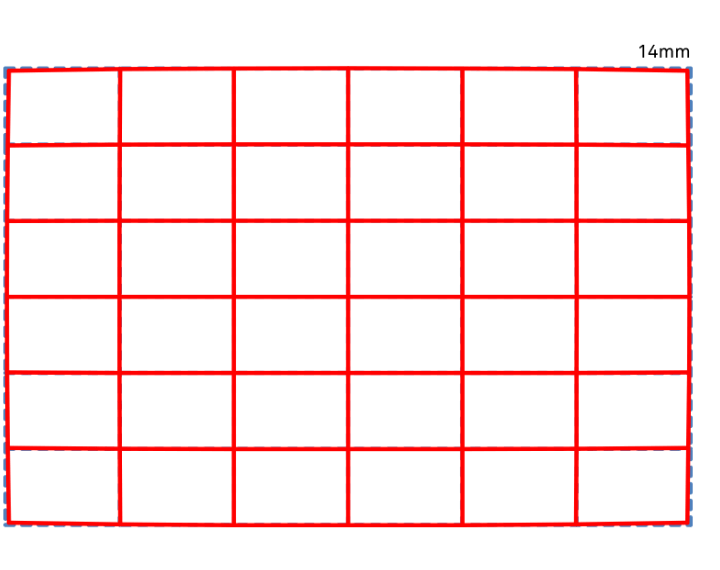
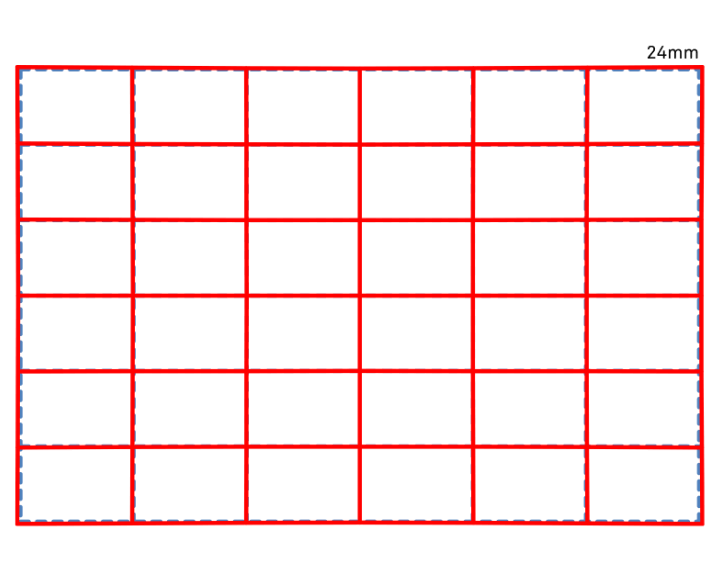
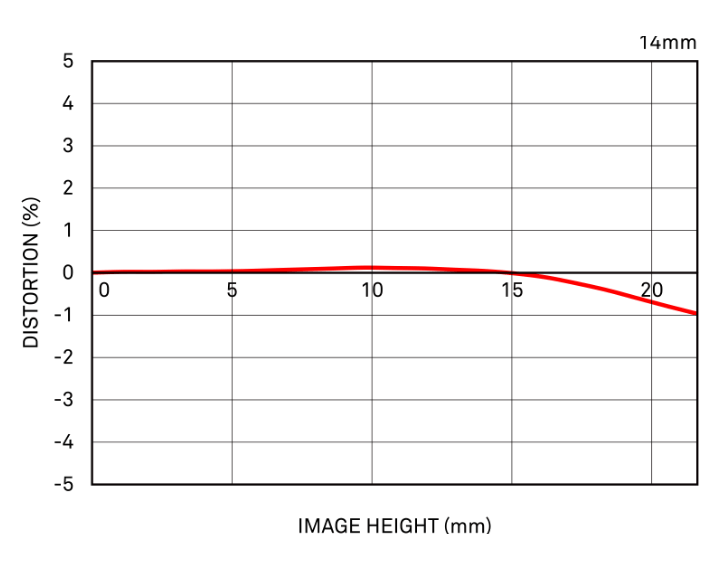
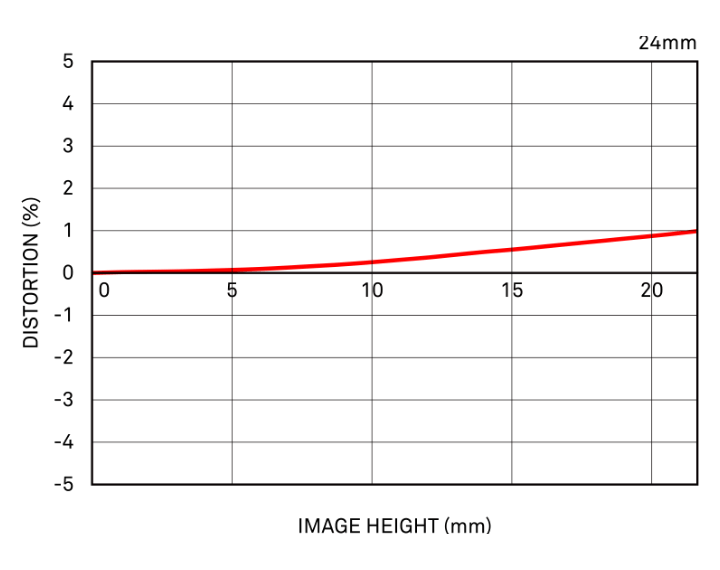
Vignetting
The horizontal axis shows the image height (the distance from the center to the edge of the image [mm]).The vertical axis shows the amount of light in the image (based on the amount of light in the image center being 100%). If the peripheral amount of light is lower than the center, the four corners of image will be darker (vignetting).
-
F2.8
-
F5.6
-
F11
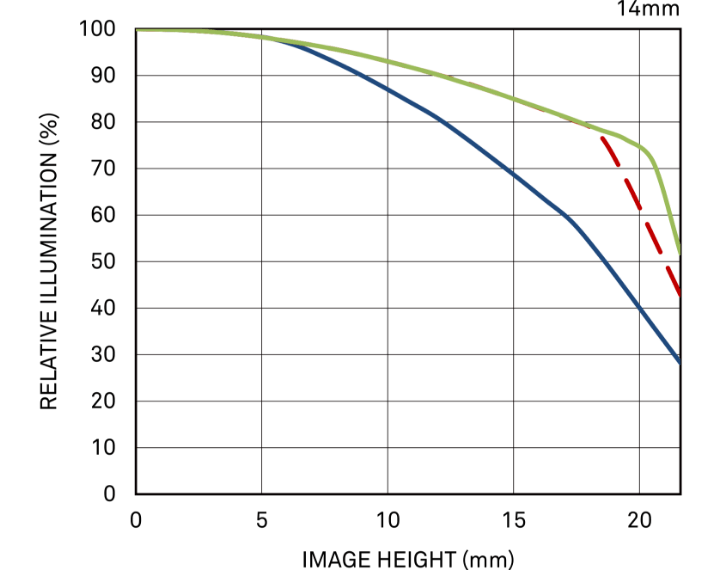
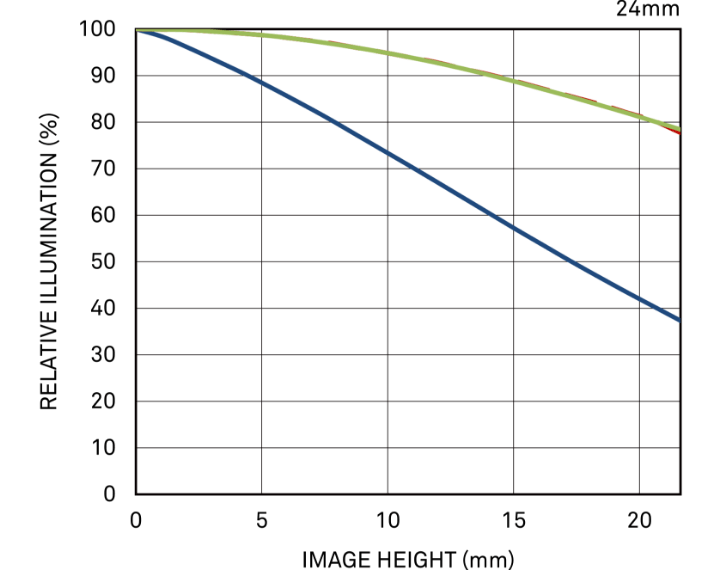

| Camera | Canon EOS 5DS R |
|---|---|
| Shutter Speed | 8s |
| Lens F Number | F2.8 |
| ISO | 3200 |
| Focal Length | 14mm |
| Photographer | Wataru Nakamura |

| Camera | Canon EOS 5DS R |
|---|---|
| Shutter Speed | 1/125s |
| Lens F Number | F2.8 |
| ISO | 100 |
| Focal Length | 16mm |
| Photographer | Wataru Nakamura |

| Camera | Canon EOS 5DS R |
|---|---|
| Shutter Speed | 1/125s |
| Lens F Number | F2.8 |
| ISO | 100 |
| Focal Length | 14mm |
| Photographer | Wataru Nakamura |
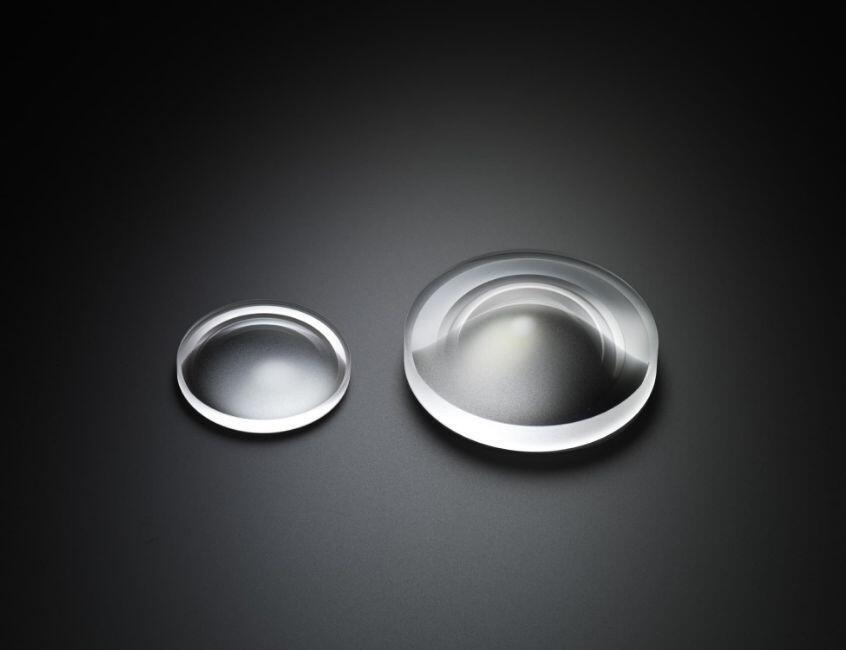
Aspherical lens elements used for Sigma 18-35mm F1.8 DC HSM | Art (left) and Sigma 14-24mm F2.8 DG HSM | Art (right).
Zero distortion.
The ultimate 14-24mm
wide-aperture zoom lens.
Setting a new standard for excellence
in ultra-wide-angle lenses
Leveraging major manufacturing advances at the Aizu factory, Sigma is now producing ultra-high-precision molded glass aspherical lens elements as large as φ80mm and incorporating them in new products. This premier optical technology promises to set a new standard for excellence in ultra-wide-angle lenses.
For the Art line, Sigma began development simultaneously of two ultra-wide-angle lenses offering the key focal length of 14mm: one prime, and one zoom. In 2017, the company launched the 14mm F1.8 DG HSM | Art as the ultimate ultra-wide-angle prime lens. This lens offers outstanding image quality in combination with F1.8 brightness.
Now Sigma is introducing the 14-24mm F2.8 DG HSM | Art as the ultimate ultra-wide-angle zoom. While minimizing distortion, this lens offers outstanding F2.8 brightness throughout the zoom range and delivers top-level image quality at every focal length and every shooting distance. For these reasons, it is the definitive large-diameter ultra-wide-angle zoom lens.